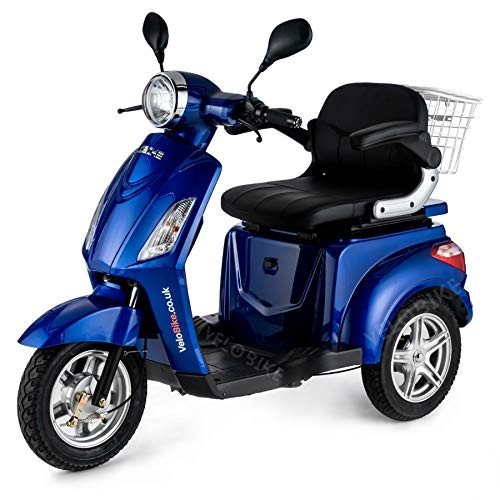Guide To Mobility Scooters UK: The Intermediate Guide For Mobility Scooters UK
Navigating the World of Mobility Scooters in the UK
Mobility scooters have actually ended up being a necessary tool for lots of in the United Kingdom, using a practical and dignified option for people with mobility concerns. These scooters not only enhance the quality of life for their users but also supply a sense of independence and freedom. This comprehensive guide intends to provide an overview of mobility scooters in the UK, including their advantages, types, purchasing considerations, and upkeep tips.

Introduction to Mobility Scooters
A mobility scooter is a battery-powered vehicle created to assist people with walking problems or restricted mobility to walk around more easily. Unlike manual wheelchairs, which require substantial physical effort, mobility scooters are simple to run and can be used both inside and outdoors. They are especially helpful for older grownups and individuals with disabilities, permitting them to take a trip longer distances and browse various terrains with ease.
Advantages of Mobility Scooters
Self-reliance and Freedom
- Mobility scooters empower users to travel separately, minimizing the need for support from others.
- They can be utilized for day-to-day activities such as shopping, going to friends, or going to gatherings.
Affordable
- While there are initial costs, mobility scooters can be a cost-efficient option to other mobility help, specifically gradually.
- Numerous models are available for lease or lease, providing versatility for users with differing needs.
Comfort and Safety
- Scooters are designed with ergonomic seats and adjustable features to guarantee comfort throughout long periods of use.
- Security functions such as lights, horns, and braking systems enhance user confidence and security.
Social Inclusion
- By allowing people to take part in neighborhood activities, mobility scooters promote social inclusion and decrease sensations of seclusion.
Health Benefits
- Regular use of a mobility scooter can assist maintain physical health by encouraging users to stay active and engaged.
Kinds Of Mobility Scooters
Mobility scooters in the UK be available in numerous types, each developed to deal with various needs and preferences:
Class 2 Scooters (Pavement Scooters)
- Speed: Up to 4 mph
- Usage: Designed for usage on pavements and within indoor spaces
- Benefits: Compact and lightweight, perfect for short ranges and everyday errands
Class 3 Scooters (Road and Pavement Scooters)
- Speed: Up to 8 mph on roads and 4 miles per hour on pavements
- Usage: Suitable for longer journeys and can be used on both roads and pavements
- Benefits: More robust and capable of handling different terrains, including rough surface areas and inclines
Off-Road Scooters
- Speed: Varies, however typically greater than Class 2 and Class 3 scooters
- Use: Designed for off-road usage, including parks, routes, and uneven surface areas
- Benefits: Enhanced sturdiness and traction, suitable for adventurous users
Travel Mobility Scooters
- Speed: Varies, however generally as much as 4 mph
- Usage: Portable and simple to dismantle for transport
- Advantages: Perfect for users who take a trip regularly and need a portable solution
Buying Considerations
When buying a mobility scooter, several factors ought to be considered to make sure the best fit for the user's needs:
User's Physical Condition
- Weight Capacity: Ensure the scooter can support the user's weight.
- Height and Reach: Choose a design that is adjustable to fit the user's height and reach easily.
Planned Use
- Indoor/Outdoor: Determine if the scooter will be utilized primarily inside your home, outdoors, or both.
- Terrain: Consider the kind of surface the user will browse, consisting of any hills or rough surface areas.
Battery Life and Range
- Battery Type: Lithium-ion batteries are normally more effective and longer-lasting than lead-acid batteries.
- Range: Check the scooter's range to ensure it fulfills the user's day-to-day travel needs.
Security Features
- Brakes: Look for scooters with reliable braking systems.
- Lights and Horns: Essential for presence and notifying others.
Guarantee and Customer Support
- Service warranty: Ensure the scooter includes a comprehensive guarantee.
- Consumer Support: Choose a reliable producer with excellent customer care and support.
Upkeep and Safety Tips
Appropriate maintenance is important to guarantee the longevity and security of a mobility scooter:
Regular Battery Checks
- Charging: Always keep the battery charged to prevent deep discharge.
- Cleansing: Keep the battery compartment tidy and totally free from dirt and wetness.
Tire Maintenance
- Inflation: Regularly check and keep correct tire pressure.
- Evaluation: Inspect tires for wear and damage, changing them as needed.
Clean and Lubricate
- Cleaning: Wipe down the scooter regularly to keep it totally free from dirt and grime.
- Lubrication: Lubricate moving parts to prevent rust and guarantee smooth operation.
Safety Checks
- Brakes: Test the brakes routinely to guarantee they are working correctly.
- Lights and Horns: Check that all security functions are operational.
Follow Manufacturer Guidelines
- Handbook: Refer to the user handbook for particular maintenance guidelines.
- Service: Schedule regular service consult a qualified professional.
Frequently Asked Questions (FAQs)
Can anyone utilize a mobility scooter?
- No, only people with a medical requirement or disability are eligible to utilize a mobility scooter on public roads and pavements in the UK. Nevertheless, they can be utilized by anybody on private property.
Do I need a license to drive a mobility scooter?
- No, a license is not needed to use a Class 2 or Class 3 mobility scooter. Nevertheless, users must be over 14 years old and have an authentic requirement for the scooter due to a disability or medical condition.
How quick can a Mobility scooters Uk scooter go?
- Class 2 scooters have an optimal speed of 4 miles per hour, while Class 3 scooters can reach up to 8 miles per hour on roads and 4 miles per hour on pavements.
Can I take a mobility scooter on public transportation?
- Some public transportation, such as trains and buses, may enable mobility scooters, however it depends upon the specific service and the size of the scooter. It's best to contact the transport supplier ahead of time.
What is the life-span of a mobility scooter?
- With correct upkeep, a mobility scooter can last several years, generally in between 5 and 10 years.
Can I get monetary assistance to buy a mobility scooter?
- Yes, monetary assistance might be available through the Disabled Facilities Grant (DFG), local authorities, or charitable organizations. Additionally, some insurance companies may cover part of the expense.
Mobility scooters are a valuable help for individuals with mobility problems in the UK, offering a series of take advantage of increased independence to enhanced social involvement. By considering the user's requirements, the desired use, and the scooter's functions, one can pick the ideal design to improve their quality of life. Regular upkeep and adherence to safety guidelines are vital to make sure the scooter remains a trusted and safe mode of transport. For those who qualify, monetary assistance might be available to make the purchase more affordable. Whether for day-to-day usage or occasional getaways, a mobility scooter can significantly enhance the user's capability to browse the world with self-confidence and ease.
Additional Resources
- Mobility Aids UK: A thorough directory of mobility aids and scooters.
- NHS Choices: Information on mobility aids and monetary support.
- Disability Living Allowance (DLA): Guidance on getting financial backing for disability-related costs.
By exploring these resources and considering the points outlined in this guide, individuals can make an educated choice about purchasing and using a mobility scooter in the UK.


